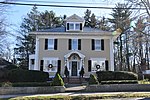House at 199 Summer Avenue
1878 establishments in MassachusettsBuildings with mansard roofsHouses completed in 1878Houses on the National Register of Historic Places in Reading, MassachusettsReading, Massachusetts Registered Historic Place stubs ... and 2 more
Second Empire architecture in MassachusettsTudor Revival architecture in Massachusetts

The House at 199 Summer Avenue in Reading, Massachusetts is designated as historic. The original two-and-a-half-story house was designed by architect Horace G. Wadlin and built in 1878 for Robert Kemp, leader of the popular Old Folks Concerts. The house was the second in Reading that Kemp had built; the first also is still standing. Originally built in the Second Empire style with a mansard roof, the house was extensively altered in the 1890s, when its mansard roof was removed and Tudor Revival styling was added.The house was listed on the National Register of Historic Places in 1984.
Excerpt from the Wikipedia article House at 199 Summer Avenue (License: CC BY-SA 3.0, Authors, Images).House at 199 Summer Avenue
Summer Avenue,
Geographical coordinates (GPS) Address External links Nearby Places Show on map
Geographical coordinates (GPS)
| Latitude | Longitude |
|---|---|
| N 42.521094444444 ° | E -71.116844444444 ° |
Address
Summer Avenue 199
01867
Massachusetts, United States
Open on Google Maps











